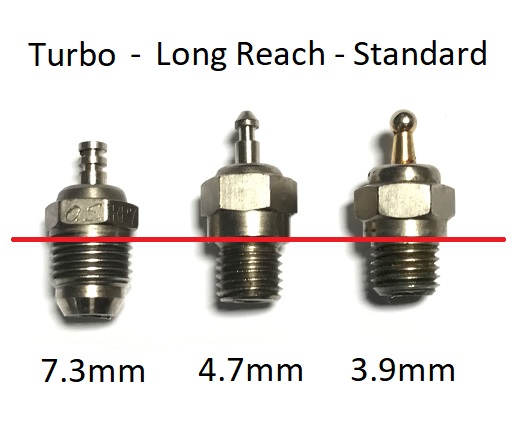No products
Prices are tax included
Product successfully added to your shopping cart
There are 0 items in your cart. There is 1 item in your cart.
OS Turbo Glowplug Type P3 (Ultra Hot)
L-OS71641300
New
Out of stock
- Write a review
More info
OS Engine Glowplug Type P3 (Ultra Hot) L-OS71641300
An ultra-hot plug for Turbo head engines.
Tough Enough to Take the Heat.
Getting the best engine performance means choosing the right glow plug, which depends on a number of different factors – the engine type, air–fuel mix, nitro percentage, and even air temperature.
What\'s more, the right glow plug will change as conditions change. Keeping a range of glow plugs on hand will help you fine–tune glow heat and enjoy maximum performance under all conditions.
Generally, hot plugs provide better idle and acceleration than cold plugs. Cold plugs will produce more power but may idle more roughly and be harder to tune.
The \"right\" glow plug for your engine is the one that gives you the best performance. And you can choose the right plug for any situation, just by following the guidelines below.
1. Engine Type
Guideline 1: Know what type of engine you have. Is it a standard - or a turbo?
Standard engines (engines with a 1-piece head) are most common. Standard plugs are easily available, inexpensive and fit almost all standard engines. Standard plugs are installed with a washer, which creates a compression seal with the head.
Many new O.S. engines are turbo engines, which feature a special 2-piece turbo head. The biggest benefit of turbo plugs is superior performance. Unlike standard plugs, turbo plugs (identified by a \"P\" in the description) feature a tapered \"seat\" that matches perfectly with the head. That creates a superior compression seal and with it, maximum efficiency and power. Turbo plugs are the choice for racers who want - and need - top performance.
A word of caution: you should never install a turbo plug in a standard engine or vice versa. Doing so risks doing serious (and expensive!) damage.
2. Displacement
Size matters to glow plugs. What size is your engine? A .12? .15? .21? Big engines have more mass and retain heat better. Smaller, lighter engines don\'t, and need the help a hotter plug can offer.
Guideline 2: The smaller the engine, the hotter the plug.
3. Fuel Nitromethane Content
What\'s the nitro percentage in your fuel? High-nitro fuels produce more power than low-nitro fuels, but also produce more heat.
Guideline 3: The higher the nitro content, the colder the plug.
4. Temperature
Smart modelers tend to keep a variety of glow plugs on hand. The reason? Because the \"right\" plug for your engine can change with the temperature. To achieve top performance, your choice of plug needs to change, too.
Guideline 4: The hotter the day, the colder the plug.
5, 6 & 7. Other Considerations
Here are a few other things you should know.
Hot plugs promote better idling and acceleration. If your engine runs rough or accelerates sluggishly, a hotter plug will help.
Cold plugs produce more power and may improve performance if your engine runs hot. The downside is rougher idling and more difficulty in tuning.
Where you run also plays a part. If the track/course has a lot of twists and turns, a hot plug is fine. If the track/course has long straights where you\'ll reach maximum rpm, a colder plug is best.
Fuel-air mix not only affects how your engine performs; it can also have an impact on how long your plug lasts. If you run rich, it means that you\'re using more fuel than necessary for top performance. Modelers are often advised to run rich during engine break-in, because it helps cool the engine. However, running too rich can also cause an engine to \"bog down\" or quit entirely. In addition, it also means that the glow element is being exposed to more contaminants than necessary, which shortens plug life.
Running lean means that you\'re using less fuel. \"Leaning down\" an engine has a positive effect on performance. However, care is needed here, because over-leaning an engine can harm it, by raising operating temperatures, \"burn up\" a plug before its time.
Final Thoughts
Choosing the right glow plug not only improves performance, but can also extend the life of your engine and the glow plug itself. With the guidelines above and the tips below, you\'re well on your way to achieving both.
- Buy quality plugs. You\'re protecting your investment.
- Store plugs where it\'s dry. Moisture can ruin them.
- Use the right glow plug. Follow the guidelines above.
- Follow proper break-in procedures.
- Tune your engine carefully. Running too lean will make your engine \"blow\" plugs more often. Proper tuning helps extend plug life.
- Never touch the filament of a glow plug. Doing so can break the filament and ruin a plug.
- Don\'t over-tighten your plug. Tighten it until it\'s just snug.
- Be sure to shim your engine correctly. A plug that\'s too close to the piston can cause detonation, which will quickly damage a glow plug.
- Use only a glow starter or 1.5V battery to heat your plug. Otherwise, your plug may burn out ahead of its time.
- Don\'t be afraid to ask for help. Experienced modelers have already \"been there, done that.\" Their experience can save you time and money - and most are glad to help.
How a Glow Plug Works
Spark plugs in gasoline engines cause ignition with a spark. In nitro engines, glow plugs cause ignition with heat.
Heat is created initially by connecting a glow starter or 1.5V battery to the plug. Once the plug comes up to heat, the battery is disconnected and the heat retained by the combustion chamber will keep the engine running. Engine timing is automatic and controlled by engine rpm. Running at higher rpm makes the plug hotter and \"fire\" the fuel-air mix sooner. At lower rpm, the filament cools and the plug fires less frequently.

Reviews





